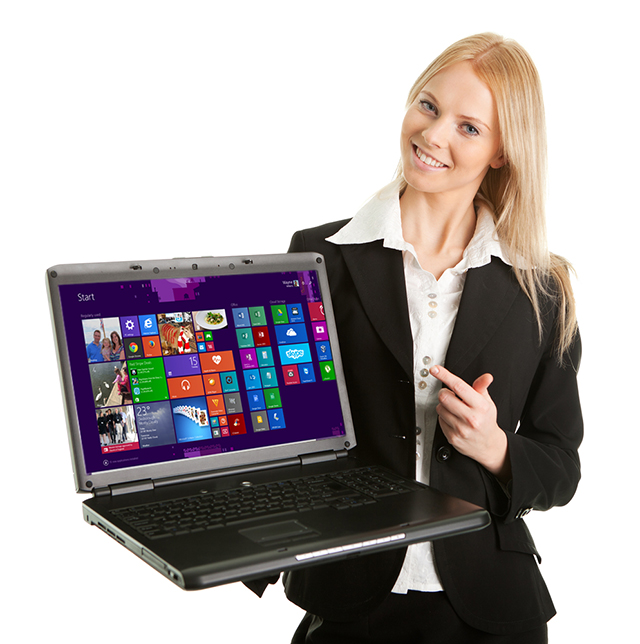The PC: A companion device for your smartphone

New in stores: It’s the "Personal Computer" -- the ultimate companion device for your smartphone or phablet!
Ever wished your mobile device had a larger screen? Or that there was a better way to input long documents than tapping tiny little virtual keys on a slab of glass (or sapphire)? Well, then you’re a perfect candidate for PC ownership.
A PC is like your smartphone -- only bigger! It has its own processor (typically dual-core or better); its own internal storage (several hundred GB is common); a really big screen (you can almost see the pixels); and a physical keyboard that lets you type like the wind (you use your fingers)!
Skeptics Abound
Now, I know what you’re thinking: Why would you want to lug around such a big, heavy device? After all, your smartphone puts the world in the palm of your hand. It has the best apps, the best games -- heck, it’s the center of the tech innovation universe!
And what about your data? How will you keep the work you do on your companion PC consistent with the original versions on your mobile device?
The answer is "the cloud". Yes, PCs aren’t just bigger -- they’re also cloud-connected! Everything you do on your companion PC can be synchronized back to your mobile device through one of several available cloud services. So when you go into that big meeting and pull out your smartphone, the changes you made on your PC are right there in the original file.
But what about ecosystems? Are there enough apps available to make a companion PC truly useful?
In a word, yes. The PC app ecosystem has been growing steadily in recent years. Many popular productivity tools, like Microsoft Office, are now available on leading PC platforms (though in a less efficient, touch-unfriendly format). And while you won’t find certain critical apps on a PC (Snapchat and Instagram are notably missing), the devices do come with fairly capable web browsers that let you visit many of these services through their legacy "web" interfaces. Just be realistic with your expectations and you’ll do fine.
Sound exciting? Then read-on for some valuable tips on choosing the right companion PC.
Buying Into the Companion PC Vision
When shopping for a companion PC, platform selection is critical. If you’re an Apple user, a Macbook running OS X will feel right at home. The underlying platform is a close cousin of the company’s popular iOS platform, although one that’s based on an earlier, less-refined architecture. Expect to pay a premium for these devices since they tend to hew closely to the superficial (yet polished) design aesthetic that made you buy into Apple’s iDevice ecosystem in the first place.
If you’re primarily an Android user, PCs running Linux will feel the most familiar. As with OS X and iOS, Linux is an early, less-refined precursor to today’s Android OS. Like Android, it’s full of hidden tweaks and hacks that make tinkering with your environment a real adventure. Just be careful to read the MAN pages before recompiling your kernel.
And finally, if you’re one of those odd ducks running Windows Phone (or RT, or whatever they’re calling it lately), you’ll want to check out PCs running Microsoft’s "Windows" (NOT Phone/RT). A distant cousin of Windows Phone, Microsoft’s Windows for PCs traces its roots back to the pre-mobile era of minicomputers and other technological dinosaurs.
But be forewarned: Windows can be a bit schizophrenic as it tries (unsuccessfully) to graft touch UI concepts onto a non-touch user environment. The result can feel rather disjointed, though rumor has it the company will be scaling back this aspect in future versions. For now, if you can tolerate the platform’s funky UI -- and its insistence on dumping all your data into Microsoft’s obscure "OneDrive" cloud service -- you may find a Windows-based PC is a solid companion for your (undoubtedly sad and lonely) Windows Phone device.
Of course, no matter which companion PC platform you decide on, you’ll need to master some basic UI concepts. For example, there’s the "mouse" (think your finger, but with buttons and stuff), or in some cases, a "trackpad" (like a small, secondary touchscreen, again with buttons). And, of course, those gorgeous physical keys (not to be confused with the nearly extinct "BlackBerry" variety). Did I mention you use your fingers (all of them)?
In conclusion, if you’re finding your smartphone or phablet’s 5-6 inch screen a bit cramped, you really should check out one of the above described companion PC platforms. A companion PC has the potential to greatly expand your mobile device’s functionality (if not its capabilities) through a larger screen, more storage and a physical keyboard.
And if you’re worried about having to master yet another platform UI, don’t fret: The next generation of companion PCs are rumored to do away with the local OS entirely. Think a seamless extension of your mobile environment to a big screen format, with a physical keyboard and other expansion options -- all powered by the Internet of Things.
Now that’s the companion PC device I want!
Image Credit: Andrey_Popov/Shutterstock
